PENILAIAN MENENGAH RENDAH 2003
Information for Candidates
1. This question paper consists of 75 questions.
2. Answer all questions.
3. Answer each question by blackening the correct space on the answer sheet.
4. Blacken only one space for each question.
5. If you wish to change your answer, erase the blackened mark that you have made. Then blacken the space for your new answer.
6. The diagrams in the question provided are not drawn to scale unless stated.
For Question 1 to Question 50, each question is followed by four choices of answers. Choose the best answer for every question and blacken the corresponding space on the objective answer sheet.
1. Which apparatus is most suitable for measuring 20.6 cm3 of liquid?
(A) 50 cm3 measuring cylinder
(B) 50 cm3 burette
(C) 50 cm3 beaker
(D) 25 cm3 beaker
2. The information given below shows the procedure for the black box experiment.
|
P To make an observation Q To make a rational conclusion R To analyze and interpret data S To collect and record data
|
Which of the following sequences is correct?
A S -> P -> Q -> R
B P -> S -> Q -> R
C S -> P -> R -> Q
D P -> S -> R -> Q
3. Figure 1 shows two bottles P and Q which can contain chemicals.
4. Figure 2 shows the apparatus used in an experiment.
Which statement best explains the observations in the experiment?
A Limestone reacts with the dilute acid.
B A gas is released when limestone reacts with the dilute acid.
C Limestone reacts with the dilute acid to extinguish the lighted splinter.
D Limestone reacts with the dilute acid to release a gas, which will extinguish the lighted splinter.
5. Figure 3 shows four organisms that live in water. L and M have chloroplasts but K and N have no chloroplast.
Which of the following statements is correct?
A L, M and N can move but K cannot.
B K has a cell membrane but L, M and N do not.
C L and M can make their own food but K and N cannot.
D K and N are unicellular but L and M are multi-cellular.
E
6. Figure 4 shows the arrangement of particles in matter P, Q and R.
Which of the following substances are represented by P, Q and R?
|
|
P |
Q |
R |
|
A |
Oil |
Water |
Water vapour |
|
B |
Iron |
Alcohol |
Oxygen |
|
C |
Sugar |
Mercury |
Ice |
|
D |
Hydrogen |
kerosene |
cork |
7. Figure 5 shows the arrangement of an experiment on the electrolysis of water.
Which of the following does not occur when the switch is on?
A Oxygen is collected at electrode X.
B Hydrogen is collected at electrode Y.
C Both oxygen and hydrogen are collected at both electrodes X and Y.
D Oxygen is collected at the positive electrode and hydrogen is collected at the negative electrode.
8. Figure 6 shows an energy flow.
Which of the following are represented by W, X, Y and Z?
|
W |
X |
Y |
Z |
|
A. Fungi |
caterpillar |
Snake |
Eagle |
|
B. Paddy |
Rat |
Eagle |
Caterpillar |
|
C. Fern |
Goat |
Eagle |
Snake |
|
D. Grass |
Caterpillar |
Snake |
Frog |
9. Table 1 shows the sources of energy and their descriptions.
|
Sources of energy |
Description |
|
P |
Energy obtained from the decomposition of organic waste products or dead organism. |
|
Q |
Energy obtained from dead plants and animals deposited on the sea bed and compressed between rocks. |
|
R |
Energy obtained from the core of the Earth. |
TABLE 1
Which of the following are represented by P, Q and R?
|
P |
Q |
R |
|
A Coal |
Natural gas |
Petroleum |
|
B Coal |
Coal |
Geothermal |
|
C Biomass |
Petroleum |
Geothermal |
|
D Biomass |
Natural gas |
Petroleum |
10. Figure 7 shows a boy using a straw to drink.
Which of the following observations and explanation are true about the air pressures at X, Y and Z?
|
Observation |
Explanation |
||
|
Pressure at X, Y and Z compared to the atmospheric pressure |
|||
|
|
X |
Y |
Z |
|
A. Water can be sucked up |
Different |
Same |
Different |
|
B. Water can be sucked up |
Same |
Same |
Same |
|
C. Water cannot be sucked up |
Same |
Different |
Same |
|
D. Water cannot be sucked up |
Different |
Different |
Same |
11. Figure 8 shows a student blowing a small piece of paper into a bottle. The piece of paper is blown out instead.
This is because
A The volume of the air in the bottle remains the same.
B The air pressure in the bottle is higher than that outside the bottle.
C The density of the air in the bottle is higher than that outside the bottle.
D The mass of the air in the bottle is more than the mass of the air blown out by the student.
12. Figure 9 shows the change in the size of a balloon when hot water is poured into a beaker.
What conclusion can be drawn from your observation?
A The size of the balloon increases because the air pressure in the balloon increases.
B The size of the balloon increases because the wall of the balloon becomes more elastic.
C The balloon floats because the kinetic energy of the air in the balloon decreases.
D The balloon floats because the atmospheric pressure increases.
13. A student is investigating the factors which affect the rusting of an iron nail. Which of the following iron nails will not rust after one week?
A. 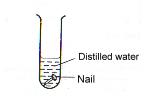
C. 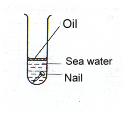
14. Figure 10 shows a bimetallic strip being heated.
Why would the bimetallic strip bend when it is heated?
A Metal Q is hotter than metal P.
B Metal P expands more than metal Q.
C The size of atoms increases more in metal P than that in metal Q.
D The kinetic energy of the atoms in metal Q increases more than that of metal P.
15. A white shirt is suitable as a school uniform because white is a
A Good emitter of heat.
B Good reflector of heat.
C Good absorber of heat.
D Good filter of ultraviolet rays.
16. Figure 11 shows the areas of taste in a human tongue.
Which areas are most sensitive to salt, sugar and vinegar?
|
Salt |
Sugar |
Vinegar |
|
A 1 |
4 |
2 |
|
B 1 |
3 |
4 |
|
C 2 |
3 |
1 |
|
D 2 |
4 |
3 |
17. Figure 12 shows the light path and impulse in the eye.
Which of the following parts of the eye are represented by W, X, Y and Z?
|
W |
X |
Y |
Z |
|
A. cornea |
pupil |
Vitreous humour |
Optic nerve |
|
B. pupil |
Vitreous humour |
cornea |
Optic nerve |
|
C. cornea |
Vitreous humour |
Optic nerve |
pupil |
|
D. pupil |
Optic nerve |
Vitreous humour |
cornea |
18. Figure 13 shows four test tubes, P, Q, R and S with different temperatures and volumes of water. The surrounding temperature is 300C.
Which of the following sequence of test tubes contain quality of heat in ascending order, after 10 minutes?
A R, P, Q and S
B R, P, S and Q
C P, R, S and Q
D P, R, Q and S
19. Figure 14 shows light ray traveling through a glass block.
Which angles are represented by P, Q, R and S?
|
P |
Q |
R |
S |
|
A. Angle of incidence |
Angle of refraction |
Angle of refraction |
Angle of incidence |
|
B. Angle of incidence |
Angle of refraction |
Angle of incidence |
Angle of refraction |
|
C. Angle of refraction |
Angle of incidence |
Angle of incidence |
Angle of refraction |
|
D. Angle of refraction |
Angle of incidence |
Angle of refraction |
Angle of incidence |
20. The inner wall of a hall is made of soft material so that
A Echoes are produced.
B The pitch of the sound increases.
C Sound is reflected.
D Absorption of sound occurs.
21. P and Q in Figure 15 show two types of eye defect.
Which type of lens can be used to correct the defects in P and Q?
|
P |
Q |
|
A. Convex lens |
Concave lens |
|
B. Convex lens |
Convex lens |
|
C. Concave lens |
Convex lens |
|
D. Concave lens |
Concave lens |
22. The information below shows the data in an experiment to determine the density of a liquid.
|
Mass of measuring cylinder = 150 g Mass of measuring cylinder and liquid = 280 g Volume of liquid = 130 cm3
|
The density of the liquid in g cm-3 is
A 0.5
B 1.0
C 2.1
D 3.3
23. Figure 16 shows a liquid being collected in an evaporating dish.
Liquid X can be identified by using
A Hydrogen carbonate indicator
B Anhydrous copper sulphate
C Litmus paper
D Lime water
24. At which stage is alum added is a water treatment plant?
A Filtration
B Sedimentation
C Coagulation
D Chlorination
25. P, Q, R and S are stages found in the water treatment system.
|
P Filtration Q Coagulation R Chlorination S Water collection at a dam
|
Which of the following sequences is correct?
A Q -> P -> R -> S
B Q -> R -> S -> P
C S -> R -> P -> Q
D S -> Q -> P -> R
26. Table 2 shows the results of food tests done on a food sample.
|
Food test |
Result |
|
A few drops of iodine is added to the food sample. |
It turns dark blue. |
|
Million reagent is added to the food sample and heated. |
Brick red precipitate is formed. |
TABLE 2
Which of the following food contain the same class of foods as in the tested?
A Egg and meat
B Bread and jam
C Milk and margarine
D Rice porridge and anchovies
27. Figure 17 shows the human digestive system.
Which of the following classes of food are digested in the organs M, N and P?
|
Organ M |
Organ N |
Organ P |
|
A Protein |
carbohydrate |
Fat |
|
B carbohydrate |
Protein |
Fat |
|
C carbohydrate |
Fat |
Protein |
|
D Fat |
Protein |
carbohydrate |
28. What happens when we exhale?
A The diaphragm contracts
B The rib cage moves upwards and outwards
C The volume of the thoracic cavity decreases
D The air pressure in the thorax is lower than the atmospheric pressure
29. Figure 18 shows the human respiratory system.
Which of the following parts are represented by J, K, L and M?
|
J |
K |
L |
M |
|
A Bronchus |
Bronchiole |
Trachea |
Alveolus |
|
B Trachea |
Bronchus |
Alveolus |
Bronchiole |
|
C Trachea |
Bronchiole |
Bronchus |
Alveolus |
|
D Alveolus |
Bronchus |
Bronchiole |
Trachea |
30. Owls are found in oil palm plantations. This increases palm oil production. What is the role of the owls?
A To help pollination
B To increase organic fertilizer
C To control oil palm diseases
D To control pests biologically
31. A wooden block M is pulled using a spring balance in four different situations A, B, C and D. In which situation the spring balance shows the highest reading?
A. 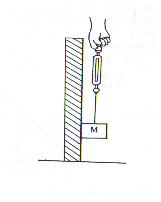
C. 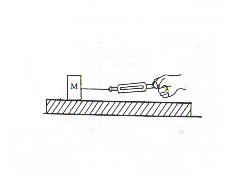
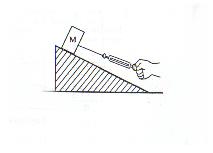
32. Table 3 shows the extension of a spring when an object is hung on it.
|
Weight of object / N |
1 |
3 |
5 |
7 |
9 |
|
Spring extension / cm |
3 |
9 |
15 |
21 |
27 |
Which of the following graphs represents the data in Table 3?
A. 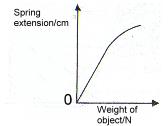
C.
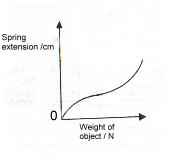
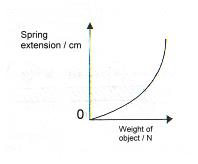
33. Figure 19 shows a ruler from which loads X and Y are hung at different points on it. Each load consists of a number of weights with equal mass.
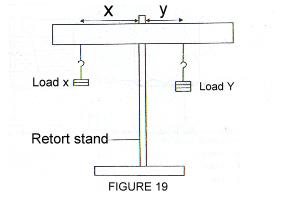
In which situation will the metre ruler not be in equilibrium?
|
Number of weights in load X |
Length x / cm |
Number of weights in load Y |
Length y / cm |
|
A 4 |
7 |
2 |
14 |
|
B 3 |
6 |
2 |
8 |
|
C 2 |
5 |
2 |
5 |
|
D 1 |
4 |
2 |
2 |
34. Figure 20 shows an experiment to study the support system in plants.
Which of the following plants use the same method of support as the balloon in Figure 20?
A Lotus
B Moss
C Paddy
D Mangrove
35. Figure 21 shows a female reproductive system.
Which processes take place at X, Y and Z?
|
X |
Y |
Z |
|
A. Implantation |
Fertilization |
Ovulation |
|
B. Implantation |
Ovulation |
Fertilization |
|
C. Fertilization |
Ovulation |
Implantation |
|
D. Fertilization |
Implantation |
Ovulation |
36. Figure 22 shows the sequence in the reproduction of a flowering plant.

(Figure 22)
Which of the following are represented by X, Y and Z?
|
X |
Y |
Z |
|
A Seed |
Fertilization |
Cotyledon |
|
B Seed |
Pollination |
Fruit |
|
C Ovule |
Fertilization |
Seed |
|
D Ovule |
Pollination |
Seedling |
37. The seeds of plant W, X, Y and Z are dispersed by different dispersal agents.
|
W Shorea X Love grass Y Lotus Z Balsam
|
Which plants have seeds dispersed by the same agent as plants W , X, Y and Z?
|
W |
X |
Y |
Z |
|
A. Lalang |
Tomato |
Coconut |
Rubber |
|
B Lalang |
Coconut |
Rubber |
Tomato |
|
C. Tomato |
Coconut |
Lalang |
Rubber |
|
D. Tomato |
Rubber |
Coconut |
Lalang |
38. Figure 23 shows an experiment to study the factors for seed germination. After two days, only the seeds in test-tubes P and Q germinated.
Which of following statement is not true about this experiment?
A Boiled water that has been cooled contains no air.
B Water and air are needed for germination.
C The dissolved air in the water helps seed germination.
D The dry cotton wool absorbs water vapour from the atmosphere.
39. The statements below describe the formation of three types of rocks U, V and W.
|
U |
V |
W |
|
Formed when magma is cooled |
Formed when the sediments on the sea bed is compressed |
Formed due to high temperature and pressure and chemical reaction |
What do U, V and W represent?
|
U |
V |
W |
|
A Igneous rock |
Metamorphic rock |
Sedimentary rock |
|
B Metamorphic rock |
Sedimentary rock |
Igneous rock |
|
C Igneous rock |
Sedimentary rock |
Metamorphic rock |
|
D Sedimentary rock |
Igneous rock |
Metamorphic rock |
40. Figure 24 shows an experiment to study the effects of moist and burnt loam on the hydrogen carbonate indicator.
Which of the following observations and conclusions of the experiment are true for flasks M and N ?
|
Observation on color of hydrogen carbonate indicator |
Conclusion |
||
|
Flask M |
Flask N |
Flask M |
Flask N |
|
A. Turned yellow |
No change |
Microorganisms present |
No microorganisms |
|
B. No change |
Turned yellow |
Microorganisms present |
No microorganisms |
|
C. Turned yellow |
No change |
No microorganisms |
Microorganisms present |
|
D. No change |
Turned yellow |
No microorganisms |
Microorganisms present |
41. Figure 25(i) and Figure 25(ii) show two transformers. Identical bulbs M1, M2 and M3 are connected as shown in the figures. The voltage across M1 is the same in each circuit.
Which statements are true about the brightness of the bulbs M1, M2 and M3?
|
M1 |
M2 |
M3 |
|
A Brighter than M2 |
Less bright than M3 |
Less bright than M1 |
|
B Less bright than M3 |
Brighter than M1 |
Less bright than M2 |
|
C Brighter than M2 |
Less bright than M3 |
Brighter than M1 |
|
D Less bright than M3 |
Brighter than M1 |
Brighter than M2 |
42. The bulbs, ammeters and dry cells in the following circuits are identical. Which circuit shows the highest ammeter reading?
A.
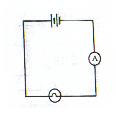
C.

43. Figure 26 shows an iron nail coil with an insulated copper wire.
When the switch is on, the iron nail will become
A A conductor
B A transformer
C An electromagnet
D A permanent magnet
44. Which of the following works on the same principle as an electric bell?
A Compass
B Hair dryer
C Bicycle dynamo
D Electromagnet
45. Which of the following symbols match with its electronic component?
|
Symbol |
Component |
|
A.
|
Capacitor |
|
B. |
Rheostat |
|
C. |
Transistor |
|
D.
|
Diode |
46. The electrical tariff rate for a household is as follows:
|
First 100 units 20 sent per unit Second 200 units 25 sent per unit Additional units 28 sent per unit
|
What is the cost of using 350 units of electricity?
A RM70.00
B RM74.00
C RM84.00
D RM98.00
47. The information below are the characteristics of a planet in the Solar System.
|
· Lowest density · Second largest · Has rings around it
|
The planet is
A Mars
B Jupiter
C Saturn
D Uranus
48. Figure 27 shows four positions of the Earth encircling the Sun.

At which position does the Southern Hemisphere experience the same length of day and night?
A X and Y
B X and Z
C W and Y
D W and Z
49. Figure 28 shows three different positions of the Moon at P, Q and R, during an eclipse.
Which of the states of the moon would be seen from the Earth during the eclipse?
A.
B.
C.
D.
50. The information below describes three different objects X, Y and Z in the Solar System.
|
X - Rocks that reach the Earth Y - Rocks that float in space Z - Rocks that enter the Earths atmosphere
|
What are represented by X, Y and Z?
|
X |
Y |
Z |
|
A Meteorite |
Meteoroid |
Meteor |
|
B Meteor |
Meteorite |
Meteoroid |
|
C Meteoroid |
Meteorite |
Meteor |
|
D Meteoroid |
Meteor |
Meteorite |
For Question 51 to Question 75 each question has I, II and III as suggested answers. Determine whether each suggested answer is correct or incorrect. Then choose one correct answer from A, B, C and D as follows:
A If I, II, and III are true
B If only I and II are true
C If only II and III are true
D If only I is true
|
Summarized instruction |
|||
|
A I, II dan III |
B I dan II only |
C II dan III only |
D I only |
51. Which step can produce complete burning of gas from a Bunsen burner?
III. Shield the flame by using a wind shield
52. The green pea plant can be categorized as a dicotyledonous because it has
I. A tap root
II. Net veined leaves
III. Flowers
53. A container is made of a thin metal sheet. Some water is boiled in the container which is then sealed. Cold water is then poured onto the container. What happens?
I. Steam changes to water
II. The container becomes dented
III. The pressure in the container becomes lower
54.

Based on the equation above, which of the following are represented by X, Y and Z?
|
X |
Y |
Z |
|
I. Hydrogen |
Oxygen |
Water |
|
II. Oxygen |
Carbon |
Carbon dioxide |
|
III. Iron |
Sulphur |
Iron sulphide |
55. Figure 29 shows moist blue litmus paper placed in a polythene bag containing exhaust gas. After a few minutes, the litmus paper turns red.
Which of the following substances in the exhaust gas can cause the litmus paper to change color?
I. Carbon dioxide
II. Water vapour
III. Soot
56.

In which of the following do the above energy changes occur?
I. Radio
II. Train
III. Lorry
57. Figure 30 shows an arrangement of apparatus where the iron nails do not rust.
Which of the substances could be represented by X?
I. Silica gel
II. Anhydrous calcium chloride
III. Anhydrous copper sulphate
58. Which of the following is/are true about the transmission of heat from the Sun to the Earth?
I. Heat is transmitted by radiation
II. Heat is transmitted by particles
III. Heat is transmitted by convection in outer space
59. Figure 31 shows an arrangement of an experiment to study tropism.
Which of the following conclusions can be drawn from observation of the roots and shoots of the seedlings after two days?
I. The roots show positive geotropism
II. The roots show positive hydrotropism
III. The shoots show positive phototropism
60. Table 4 shows solutions P, Q and R with their respective pH values.
|
Solution |
P |
Q |
R |
|
pH value |
4 |
7 |
10 |
Which of the following statements is / are true?
I. Solution P reacts with calcium carbonate
II. Solution Q does not react with calcium carbonate
III. Solution R reacts with calcium carbonate to give off carbon dioxide
61. A food sample is taken from organ Q shown in Figure 32. After analysis, the pH value of the sample is 3.
Which of the following statement explain this condition?
I. Q secretes hydrochloric acid
II. Enzymes in Q change fat to fatty acids and glycerol
III. Enzymes in Q change starch to maltose
62. Figure 33 shows the cross section of stem.
What is the function of P?
I. It transports water and minerals
II. It transports food
III. It gives shape to the stem
63. The information below shows a food chain.

An increase in the population of sharks will result in
I. a decrease in the population of seals
II. an decrease in the population of fish
III. an increase in the population of plankton
64. Figure 34 shows a food chain in a paddy field.

(Figure 34)
Which of the following pyramids is / are suitable for this habitat?

65. The information below shows the general characteristics of an animal.
· Huge
· Thin layer of hair
· Broad and thin ear pinna
· Wrinkled skin
Where could you find that animal?
I. Tropical zone
II. Desert
III. Cold zone
66. Which of the following actions is / are suitable for the conservation of the orang utan?
I. Build more reproduction centers
II. Establish forest reserves
III. Establish more recreational and tourist centers in the forest
67. Which of the following factors will increase the work done?
I. Increase the force
II. Increase the distance
III. Increase the time
68. Which of the following is/are asexual reproduction?
I. Binary fission
II. Spores production
III. Vegetative reproduction
69. Figure 35 shows three students P, Q and R sitting on a see-saw with F as the fulcrum. The see-saw is in equilibrium.
Which of the following actions will cause R to go up?
I. R moves towards F
II. P moves towards F
III. Q moves towards F
70. Table 5 shows the characteristics of petroleum fraction obtained from fractional distillation.
|
Petroleum fraction (boiling point) |
Color of distillate |
Viscosity of distillate |
Formation of soot after combustion |
|
First distillate (100oC 120oC) |
Colorless
|
Not viscous |
No soot
|
|
Second distillate (121oC 170oC) |
Light yellow
|
Less viscous |
A little soot |
|
Third distillate (171oC 220oC) |
Yellow
|
Viscous |
A lot of soot |
TABLE 5
Which of the following statement is/are true?
71. Object S is carried vertically from the floor onto the table top. Then the object is pulled horizontally as shown in Figure 36.

(Figure 36)
Which of the following statements is/are true about the work done?
72. The information below describes the observations of some rocks.
· Dull surface
· Stratified
· Fossilized
· Non crystallized
What type of rocks are they?
I. Sedimentary
II. Igneous
III. Metamorphic
73. Figure 37 shows circuit containing an uninsulated heating coil.
Three similar circuits are designed using two, three and four dry cells of the same voltage.
Which of the following circuits show the same temperature as that in Figure 37 when the switch is on for two minutes?
74. Which of the circuits will light up the bulb when the switch is on?
75. Which phenomena do not occur in the sun?
I. Supernova
II. Sun spot
III. Prominence
*** End of Question ***